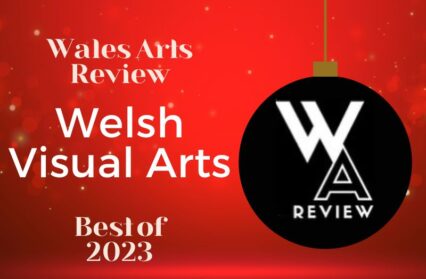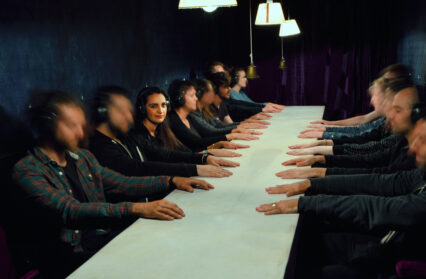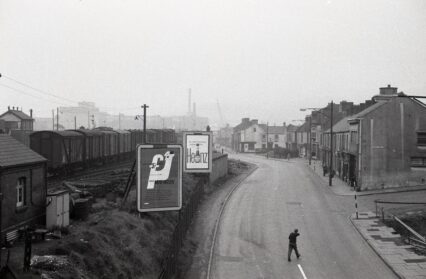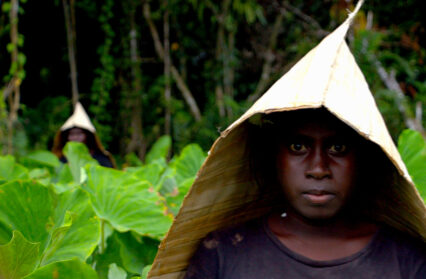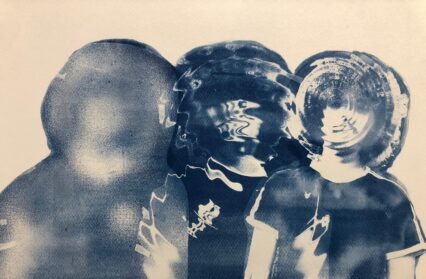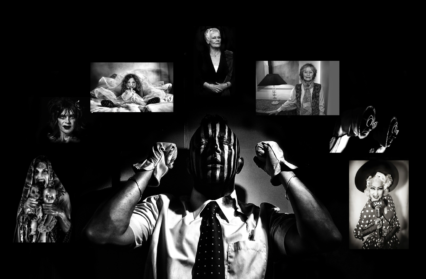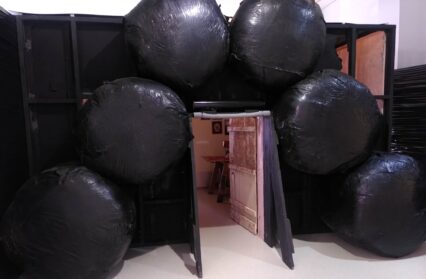James Lloyd explores how Ynys Mon’s Plas Bodfa has adapted a wide-ranging exhibition for the lockdown period, and moved Unus Multorum, One of Many entirely online.
In her first video of a series called “Unus Multorum – the week formerly known as installation week” Julie Upmeyer, the curator of Plas Bodfa fiddles with the camera before sitting down by a table of abandoned tools. The house is empty and quiet. “I bring you the first of a series of poorly shot videos,” she laughs, turning her focus to the table of tools beside her. Her gaze lingers on one of the objects. “At this point the only thing that really seems useful on this table is this.” She picks up the gas mask and holds it up to the camera.
The theme and title of Plas Bodfa’s second exhibition is Unus Multorum, meaning “one of many”, a latin pseudonym used by the Romans to sign documents anonymously. 111 artists, musicians and poets from Wales and beyond were asked to explore the theme of multiples and collectives. When it was announced in January, nobody could have quite anticipated how poignant this theme would become. Now at the beginning of April in what should have been opening week, Plas Bodfa is empty. For an indefinite period of time, nobody will be visiting to see the artwork, of which some are incomplete or were never installed. The exhibition opening and live performances of music and poetry have been cancelled.
Julie Upmeyer is striving to adapt the exhibition and its artist community to these strange times. “It’s thinking about statements and intentions as a collective,” Julie states in her opening installation week video, “the whole point of this exhibition was to think about our power as a group, our power together, so I felt the concept was more powerful than ever to get us through this.” Over the weekend, a “Just Us” Zoom chat was held where all the exhibition’s artists were invited to gather together for music, poetry and dancing. It demonstrated Plas Bodfa could continue to be a hub of its community, and the 49 contributors that gathered showed it was welcome and needed. “People are being asked to ‘self-isolate’ for an unspecified period of time, with an unknown impact on personal wellbeing,” writes Julie in an email sent to contributors, “Already people are feeling isolated and alone. For these reasons we feel it is important to continue with our project, albeit with a different structure, creating a safe environment to create and engage with those around us.” While the country is locked down, postponing or cancelling an exhibition about community didn’t seem like the right option, but it had to adapt.

The exhibition is now being transferred onto Plas Bodfa’s website as well as its Facebook, Instagram and Twitter, extending the exhibition across the whole year to make it as accessible as possible for both viewers and contributors. Unbound by the walls of the house and time constraints of the physical exhibition, new contributions from artists will be continually added when they are ready. Live performances may be transformed into live streams, the event recorded in the rooms of Plas Bodfa, or over footage of the building itself. “It will unfold sporadically throughout the year,” Julie tells me via email, “I have purposely avoided any dates or time schedules for now, as I don’t want to place any additional pressure on any of the participants, or myself… The brutal reality is, I have absolutely no childcare during this time and I have not received any funding for this show, so my family, life and work balance is extremely precarious.” Julie now has to use her children’s nap times or borrow from her sleep to organise and communicate with 111 contributors, some of whom are as far as Australia and America.
Despite the hardship, Unus Multorum’s new fluidity is an exciting prospect. Freed from the time and space constraints, artists are able to contribute when they are ready, to add new content that would have been limited by the opening times of the physical exhibition. Its translation into the online space is in its early days. Featured contributors are slowly being added through artist interviews, beginning with those who were able to install their work before lockdown. “Proceeding in the direction that I’m doing now is an experiment I’m trying my best to define as I go along,” Julie says.

There are clear limitations to experiencing art virtually. We are bound by the viewpoints of the camera. We cannot get close and squint or stand back and marvel. An artwork that can have an extraordinary presence in the physical can seem underwhelming viewed through camera footage. In a time of isolation however, both artist and viewer are privileged to be able to see them at all. While in its early stages, the online exhibition is already demonstrating some advantages of the platform, and can be viewed as an exhibit in itself.
In a strangely appropriate way, each contributor is self-isolated by their own thumbnail. The link takes you to the artist’s page which features a description of their work alongside a video interview that allows the artist to talk about and show their work. The standard size of each thumbnail grants each contributor an equal presence in the exhibition, a great bonus for contributors whose work is small. It allows equal weight to art that may have been overlooked because of its size. One such installation, Annie Horsley’s “The Last Lost Leaves”, are beautifully hand-crafted ceramic tree leaves no larger than the hand. They were scattered around Plas Bodfa by the artists; some left in plain sight, but others hidden away, and easily missed in the house’s many rooms. The installation becomes a much larger presence online. We can watch videos of contributors taking Annie’s leaves and placing them where they choose in the house. Through the videos, each leaf becomes more than an object but an event, a story. It is also fascinating to watch these videos and witness the exhibition slowly being installed in the background. Pieces that had not been there previously or were incomplete suddenly materialise in the next video. It is a documentation not only of The Last Lost Leaves but of Unus Multorum as a whole.
Annie Horsley is the first to take a leaf from her collection, and as she unpacks the first leaf to be placed, she is able to talk directly to us about her work. “We’ve got to find the trees again!” Annie says before talking about the individual leaf she has selected, made from clay “from a beach nearby where I live… and when the tide is low you can find the clay that’s left on the beach.” In her video interview with Julie, the artist Gwen Williams talks about the inspiration and process of her installation “Rags and a Golden Thread”. She is initially nervous about the camera, and while some of the other contributors don’t get past this Gwen warms to her subject. “Up to the 1950s in China, women used to patch their shoes with a collage of rags and rice glue.” Gwen goes on to elaborate about the history of this practise and her clear passion for the subject is both infectious and informative. Mixed with insights about the process and materials, it infuses the installation of beautiful fabric collages on black banners with a much greater depth. We see more than the object but its inception, its process and the passion involved in creating it. Often these insights cannot be conveyed through the small placard placed by their work.
There are numerous others and the range of work is diverse. Returning to Plas Bodfa, Helen Birnbaum carefully unpacks her “OUTBREAK Draughts”, where ceramic red and white blood cells oppose a variety of viruses on a draughts board. Among the parasites is Coronavirus, not dissimilar to the common cold in its appearance. Another virus, Giardia, has an unusual shape that can only be described as a wizard’s hat with coils at the peak. The peak of the “hat” has the rippled effect of a swimming stingray and the sense of motion runs through it in waves. The daily battle our immune systems undertake becomes immediate yet undeniably humorous and painfully relevant. Liz Von Graevenitz drew inspiration for her mural from the Welsh weaver William Jones. Working in the 18th century, he created over 100 weaving designs for tapestry quilts, of which are now being exhibited over Plas Bodfa’s entrance.

Other installations have since adapted to the times. Julie documents the creation of Debbie Budenberg’s “Celestial Blue”, colloquially known to her family as “The Blue Room”. “We’ve been spending a lot of time in here,” Julie says, “as soon as my three-year-old daughter saw this room she immediately, without conversation, without word, started moving in her furniture,” Julie says. It has since become the play room. In the background is a tricycle with blue rims that match the walls and a plastic red car and chair that compliment the blue in a surprisingly beautiful way. It’s funny, but it also demonstrates the attractive pull of this installation. The walls and ceiling of the room with the exception of the unfinished back wall are the infinite sky blue of hot summer. After a long winter you want to bathe in it.
Perhaps one of the most interesting installations is the collection of artist interviews, vlogs, Instagram and Facebook posts that document Unus Multorum itself. Collectively they can be viewed as an installation, and while the videos have an unpolished spontaneity, they display an honest and determined integrity. “I am learning about filmmaking and livestreaming and interactive possibilities as I go, I have no prior experience with them in the past,” Julie tells me. They offer what is an honest and unflinching look at an exhibition suddenly forced to adapt. On the Plas Bodfa Facebook page there is a photo of Julie’s two young children, sat in children’s chairs in the hallway. It’s almost a throwaway image, without too much thought or time for composition, a photograph taken in haste. There is no photo tagline. It’s as though the image captures a quick glance back to check the children are okay before starting some work on the exhibition. This image sums up Julie’s time precariously juggling work and family. “As an artist I’m finding it extremely painful to be doing something poorly,” Julie says in her first installation week video. But regardless of the quality, it is allowing us to see artwork we could not otherwise see in isolation. Art is inseparable from its context, and Julie’s work depicts these difficult times. As with the artist interviews like Gwen Williams’, Julie’s documentation provides the whole exhibition with a story, one of the importance of creating despite the challenges, because of the challenges.
It is inspiring to see an exhibition adapting in spite of difficult challenges, both for its community of viewers and contributors. Although in its early stages, its potential is evident, and it’s exciting to see what comes next. It is undeniably a loss to be restricted from seeing the art in its physical form, but being forced to adapt and explore new avenues is opening up exciting new possibilities. When things return to some semblance of normality, what is being achieved now could make an interesting and valuable supplement to onsite exhibitions in the future. I look forward to seeing more.
You can find out more about Plas Bodfa on their website


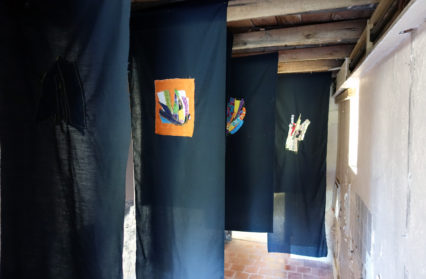
 Enjoyed this article? Support our writers directly by buying them a coffee and clicking this link.
Enjoyed this article? Support our writers directly by buying them a coffee and clicking this link.
